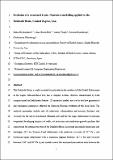Por favor, use este identificador para citar o enlazar a este item:
http://hdl.handle.net/10261/194273COMPARTIR / EXPORTAR:
 SHARE SHARE
 CORE
BASE CORE
BASE
|
|
| Visualizar otros formatos: MARC | Dublin Core | RDF | ORE | MODS | METS | DIDL | DATACITE | |

| Título: | Evolution of a structural basin: Numerical modelling applied to the Dehdasht Basin, Central Zagros, Iran |
Autor: | Heydarzadeh, K.; Ruh, Jonas Bruno CSIC ORCID ; Vergés, Jaume CSIC ORCID ; Hajialibeigi, H.; Gharabeigli, G. | Palabras clave: | Zagros fold-and-thrust belt Shortening-related diapirism Numerical modelling Minibasins Detachment levels Dehdasht Basin Zagros Iran |
Fecha de publicación: | 2020 | Editor: | Elsevier | Citación: | Journal of Asian Earth Sciences, 187: 104088 (2020) | Resumen: | The Dehdasht Basin, a small structural basin located in the southeast of the Dezful Embayment in the Zagros fold-and-thrust belt, has a complex tectonic structure characterized by both compressional and halokinetic features. 2D numerical models are used to test how geometrical and rheological parameters affected the Miocene-Pliocene evolution of this deep basin. The analysed parameters include rates of syntectonic sedimentation and erosion, thickness and viscosity of the lower detachment (Hormuz salt) and of the upper detachment (Gachsaran evaporites) developing diapiric salt walls, salt extrusions and minibasins-growth synclines that characterize the internal structure of the Dehdasht Basin. Assuming reasonable dimensions and rheologies (0.5 km Hormuz basal detachment with moderate viscosity of 1019 Pa·s, and Gachsaran upper detachment with a minimum original thickness of 1.5 km and viscosity between 5 · 1018 and 1019 Pa·s), our models reveals that an almost intermediate ratio between the rates of surface processes and deformation well approximate the geological and geophysical observations. A local decrease in the thickness of the Hormuz salt below the Dehdasht Basin with respect to surrounding regions was of great importance for its structural evolution. We suggest that the large volume of Gachsaran evaporites presently filling the basin was partly due to their gravitational flow from the emerging surrounding anticlines into the basin. The numerical experiments also demonstrate that in a compressional setting, shortening is the main factor for the rapid initial growth of the diapirs, although, with increasing syntectonic sedimentation the effect of shortening diminishes. | Versión del editor: | https://doi.org/10.1016/j.jseaes.2019.104088 | URI: | http://hdl.handle.net/10261/194273 | DOI: | 10.1016/j.jseaes.2019.104088 | ISSN: | 1367-9120 |
| Aparece en las colecciones: | (Geo3Bcn) Artículos |
Ficheros en este ítem:
| Fichero | Descripción | Tamaño | Formato | |
|---|---|---|---|---|
| Verges_Journal of Asian Earth Sciences_187_104088_postprint.pdf | 5,67 MB | Adobe PDF |  Visualizar/Abrir |
CORE Recommender
SCOPUSTM
Citations
20
checked on 22-abr-2024
WEB OF SCIENCETM
Citations
17
checked on 25-feb-2024
Page view(s)
314
checked on 23-abr-2024
Download(s)
433
checked on 23-abr-2024
Google ScholarTM
Check
Altmetric
Altmetric
Este item está licenciado bajo una Licencia Creative Commons

